
views
Evaluating If You Can Raise Chickens

Check your local laws and regulations on keeping chickens. Some municipalities will not allow you to keep chickens, or they might have some strict rules on keeping them. Before you start spending money on chickens and supplies, take the time to search your local laws and regulations online. Some places will not allow you to keep roosters because they are too noisy. This will affect you if you want to breed your hens, but it won’t prevent you from keeping hens for eggs or meat. If you plan on keeping a lot of chickens, see if there is a maximum number of chickens you can legally keep first. Depending on your circumstances, you might also need to check with your landlord or homeowner's association.

Make sure you can care for chickens on your property. Before you start acquiring chickens, you’ll want to make sure you can provide them with everything they need to keep them happy. Start by considering the space you have available. Make sure you know where the coop is going and that the chickens have enough outdoor space. Each standard size chicken should have 10 square feet (0.93 m) of space outdoors, and bantams should have 8 square feet (0.74 m). Your municipality may also require your chickens to be kept a certain distance from your property line, so check on that as well.

Start saving money for chicken care costs. Chickens aren’t cheap to care for, since you’ll need to purchase them feed for as long as they live. You also need to provide fresh, clean bedding, an adequate coop, and other necessities along the way. If you’re short of money, you can keep bantams instead of regular chickens, since they tend to be cheaper to take care of, take up less space, and eat less than regular chickens. Cost can and will vary widely, but expect to spend around $500 USD in initial costs (especially if you buy a coop) and roughly $25 per month to care for 3-4 hens.

Make sure you can fit chickens into your schedule. Chickens are not zero-maintenance animals, and will require some of your time every day. You’ll have to feed them daily, refill their water containers, clean their coop, collect their eggs, and check on them often—especially if your area has a lot of predators. Plan to spend at least 1-2 hours every day caring for your chickens.

Let your neighbors know that you’re getting chickens. Before you buy a flock of chickens, it’s nice to give your neighbors a courtesy heads-up. You don’t want to be a nuisance, after all. If your neighbors wouldn’t like the noise, consider only getting hens and no roosters, since roosters are much louder than hens. If your neighbors are worried the chickens will get into their yard, make sure to keep the chickens in an enclosed area. You can always buy a chicken coop with a run attached to it so the chickens cannot escape. If your neighbors are still not keen on you getting chickens, bribe them with a fresh supply of eggs delivered to their door!

Do some research on raising chickens. If you’ve never cared for chickens before, make sure you know what you’re getting into. Chickens can be a lot of work, and you’ll want to know how to look after them properly and how to avoid common mistakes. There is plenty of information online on websites, blogs, forums, etc. You can also get some advice from other chicken owners or purchase books about chickens.

Weigh the pros and cons of keeping chickens. There are many advantages and disadvantages of keeping chickens, and it’s a good idea to put some thought to them. On the pro side of keeping chickens, they get rid of insects and pests like snails, they’re a source of fertilizer, and they can lay fresh eggs. They're also great company, wonderful to watch, and very fun birds to raise overall. The cons of keeping chickens include the amount of money, time, and space it takes to care for them. You also have to consider the damage they can do to your plants, the noise they can make, and the fact that they can attract flies. Seek out the opinions of people you know who raise chickens.
Choosing and Acquiring Chickens

Decide on the age and the purpose of your chickens. Chickens can be kept for eggs or meat, for show, or just as pets. Whichever purpose you choose, there are plenty of breeds that are recommended for that purpose. You can purchase fertilised eggs, chicks, pullets, or laying hens. If you’re new to keeping chickens, it’s recommended that you purchase some pullets or laying hens instead of young chicks or fertilised eggs. However, incubating your own eggs can be a wonderful experience. Plan to keep at least two chickens. Chickens are social birds and they will get bored, depressed, and lonely if they don’t have a partner to socialize with. However, don’t keep more than one rooster in an enclosure, as they will fight each other and cause serious injuries.

Choose chicken breeds that suit your purposes. Some breeds are better egg-layers than others and tend to lay eggs longer. Others are best used as broiler (meat) chickens because they mature more quickly. You can also get more unique and colorful chickens, which can be kept for show, or bantams, which can be kept as pets. If you’re looking for good egg-layers, consider the Plymouth Rock, Rhode Island Red, or Leghorn breeds. These chickens tend to lay more eggs for a longer period of time. If you’re looking for chickens to use for meat, consider keeping Faverolles or Brahma chickens. If you’re looking for show breeds, research different kinds of breeds online. Generally, a show breed can be any chicken that looks particularly colorful and unique. If you’d like a simple pet chicken, consider bantam-sized chickens, which are smaller and often friendlier than the standard chicken.

Locate sources for acquiring chickens in your area. You can browse on websites that sell chickens, such as Craigslist, or you can look on bulletin boards at pet shops to see if there’s an advertisement for chickens there. You can also try asking a local farmer if they’re interested in selling a few chicks or pullets. Young chicks can also sometimes be purchased at local feed stores, or you can purchase some fertilised eggs online and get them mailed to you. Chicks are usually available in spring or summer, so if it’s winter or autumn, you might want to get some pullets instead.
Setting Up the Chickens' Home
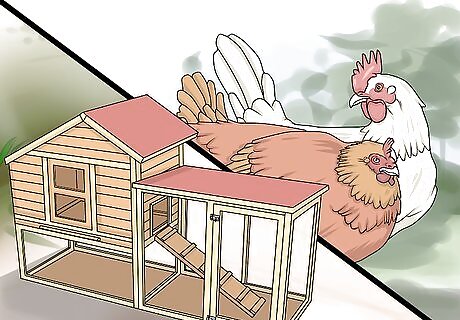
Decide whether your chickens will be kept free-range. You can let your chickens roam around in an enclosed area in your garden, let them free in a run, or permanently keep them in their housing. Free-range chickens enjoy getting more sunlight during the day, eat up any snails or slugs in the garden, have more space, and get to dust bathe in the dry dirt regularly. Chickens that are kept in a run are safe from predators, you don’t have to check on them as often, they still get to live on grass and dirt, and they get fresh air and light. Chickens that are cooped may require more work on your part, since their coop has to be cleaned up more frequently. They also don’t get as much light or fresh air, and they can’t go foraging in the grass.

Buy a chicken coop if you don’t plan to build one. All chickens need a coop to be kept in. The coop needs to be well ventilated, predator-proof, and free of drafts, and have plenty of space for the number of chickens you want to keep. You can purchase a chicken coop from a pet store, a warehouse, a ranch supply store or online. The cost can range from $200 to $600 USD, depending on the size of the coop. Your chickens should have at least 4 square feet (0.37 m) of floor space each in their coop, while bantams should have half of that (2 square feet (0.19 m)). If you’re going to keep your chickens in the coop all the time, it should be even larger so that the chickens have room to roam around.
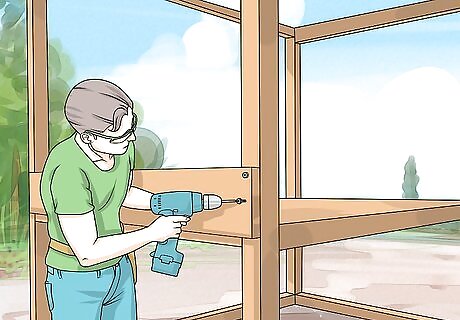
Try your hand at building a coop instead of buying one. If you have some knowledge in building things, you should be able to construct your own chicken coop. You can get many coop designs online, or design your own coop. Whether your buy or build, place the coop in an area with plenty of grass and some dirt patches. Chickens like to eat any grass they come across, and they love to dust bathe daily. Consider attaching a run to the coop so that your chickens can roam around outside, but still be protected from predators. If you cannot buy or build a coop, you can instead keep your chickens in a warm, well ventilated, predator-proof shed.
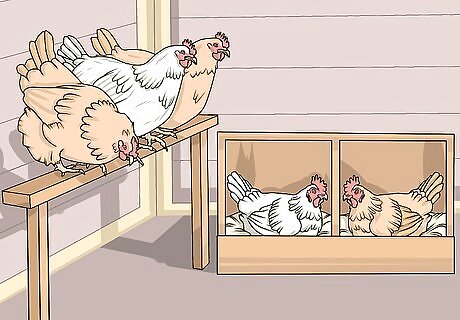
Accessorize your coop with perches, nesting boxes, and bedding. Chickens don’t usually sleep on the ground, but they often roost at night on perches or on top of nesting boxes. The number of perches you should buy depends on the number of chickens you have. Make sure the perches aren’t too thin, so that the chickens can easily rest on them. It’s also better to buy removable perches, so that you can clean them without any trouble. Purchase or build a few nesting boxes (where hens lay their eggs) to go inside of the coop. Make sure there is at least one nesting box for every four hens. You should add bedding, such as straw, to the boxes so they are more like nests. Also, make sure the boxes are big enough so that your hens can fit in them and be comfortable. Add absorbent bedding, like wood shavings or straw, to the coop. The bedding allows you to clean up the chickens’ waste quickly and easily. It should be added to the floor of the coop.
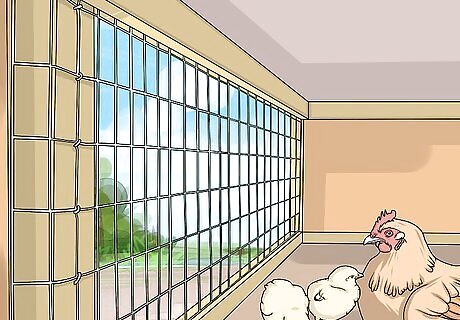
Make sure the chickens’ enclosure is safe from predators. Chickens have many predators, including raccoons, cats, and dogs, all of which can fit through cracks in the coop or fence, or dig under the coop or fence. Make sure to reinforce your chickens’ enclosure, or you may find all your chickens gone in the morning. Put up a fence around the chickens’ enclosure. Make sure the fence is made out of strong materials. Bury the fencing into the ground so predators cannot dig underneath the coop and get in. Block off any gaps that predators can fit through in the fence or coop. You can block off the gaps with a piece of wood, tile or something similar.
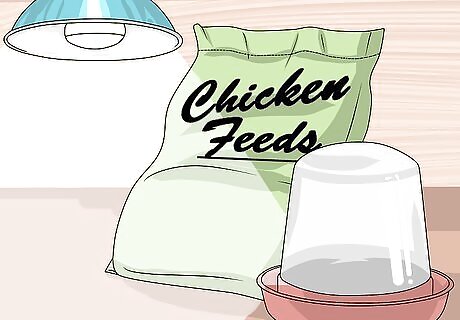
Acquire the necessary equipment to care for chickens. When caring for chickens, you’ll need to have the right feeding equipment, bedding supplies, and extra items to go in their coop. Purchase feed and water containers. You can use tubs or bowls as your chickens’ feed and water containers, or you can buy or make a feeder and drinker. If you’re planning on breeding your chickens, you’ll want to keep a drinker since it will lessen the chance of chicks drowning. Stock up on extra bedding. You can never have enough extra bedding material, since you will be disposing of the used bedding every time you clean the coop. Get a heat lamp if necessary. If you plan on breeding your hens or if it gets quite cold during winter in your area, you’ll have to invest in a heat lamp to keep your chicks and chickens warm.
Feeding Your Chickens

Choose the correct type of chicken feed. There are 3 main types of chicken feed: layer pellets, which are high in calcium and given to egg-laying hens; finisher feed, which is high in protein and give to meat chickens over 6 weeks old; and standard chicken feed that can be given to chickens in general. Food for standard-size chickens usually comes in pellet form, while food for smaller bantams often comes in crumbles. Keep the food fresh and clean. During the night, cover the food container and feed up with a lid to stop it from attracting pests, and clean up any leftovers so that they don’t turn moldy.

Supplement your chickens’ diet with high-calcium grit. Provide grit to help your chickens grind down their food and provide calcium for laying hens. Crushed oyster shells or egg shells are a great source of calcium. Free-range chickens may not need to be supplied with as much grit, as they find things in the ground to replace it. Many chicken feeds already contain calcium-rich grit. If not, you can buy it separately at the feed store and add it (according to the ratio provided on the package) to the feed. Additionally, you should let your chickens free-feed on insoluble granite grit 2-3 times per month. You can buy this at the feed store as well.
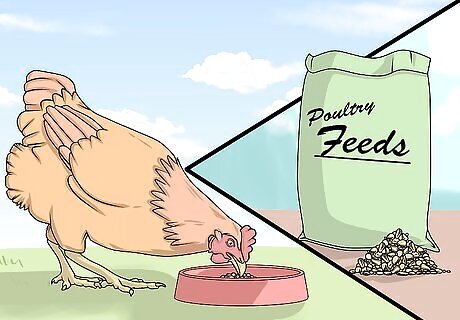
Give your chickens limited treats. Chickens can eat a wide range of foods, such as vegetables, fruits, table scraps, bugs, seeds, etc. Make chicken feed the staple of their diet, though. Never feed your chickens avocado, rhubarb, onion, garlic, uncooked potato or egg, citrus fruits, alcohol, chocolate, or anything salty. Don’t try to get rid of rotten food by giving it to your chickens either—fresh food is always best. Table scraps and other treats should make up no more than 10% of a chicken's diet.
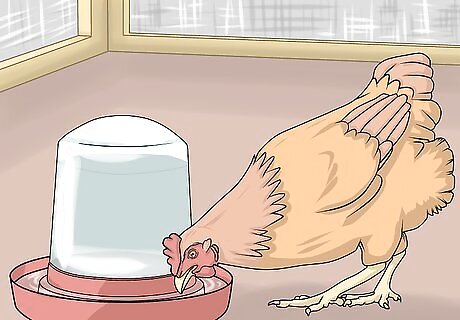
Provide fresh water for your chickens at all times. You should provide 1 gallon (3.8 L) of water for up to 3 or 4 chickens, and increase the amount based on additional chickens. Always make sure the water is fresh and clean, and remember to refill and clean the water container daily to prevent a build-up of bacteria.
Providing Other Routine Care
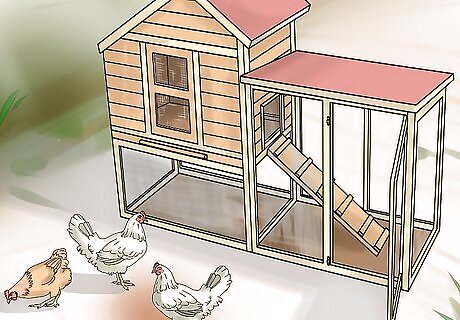
Let the chickens in and out of their coop. In the morning, let the chickens out of their coop so they have room to move around outdoors. Then, when the sun is setting, make sure to lock them up in their coop for the night. When locking the chickens up, make sure to count them so they’re all in the coop. Chickens will learn that their coop is home, and eventually settle inside the coop every night when it is time to go in. This will save you the trouble of rounding the chickens up. However, if you’re still having some trouble getting the chickens inside of their coop, throw some treats inside. The chickens should have access to their coop at all times during the day, but the coop should stay locked during the night. Chickens will come in and out of their coop to lay eggs, eat and drink (if the feeder and drinker is in the coop), and get away from the heat or the cold.
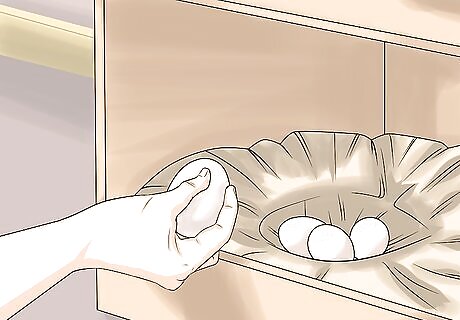
Collect the chickens’ eggs each day. Happy hens will, on average, lay 1 egg apiece every day. You should collect the eggs every morning or afternoon to make sure you are receiving a fresh supply. During the heat of summer, you should collect the eggs twice a day. You should collect the eggs in a basket, box or some sort of container. If you drop an egg, make sure to clean up the mess!
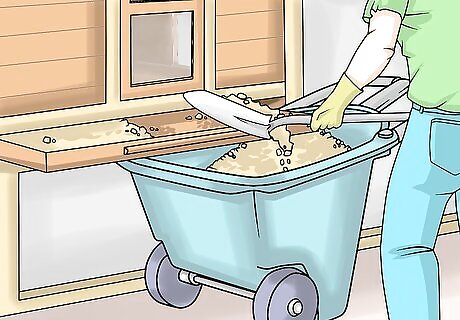
Clean the coop daily. Cleaning your chickens’ coop is very important, as it prevents pests (such as mites) and diseases. The chickens’ bedding must be replaced daily, and you must also clean the whole chicken coop from time to time—weekly, for instance. The more chickens you have, the more often you’ll need to fully clean the coop. Put on some gloves and a mask and dispose of all the bedding, sweep the floor of the housing, hose the housing down, clean out the nest boxes, rinse the feeders and drinkers, and clean the perches.

Check on your chickens daily. Do your daily routine and feed them, refill their drinker, collect eggs, etc. Then observe them and see if there is a change in appearance or behavior to make sure the chickens are healthy. Panting, cloudy eyes, sluggishness, low alertness, huddling, bald spots, a reduction in egg production, and decreased eating or drinking are all potential signs of illnesses. If you come across any of these, you should contact your vet. If one of your chickens has a bleeding wound, separate it immediately to stop the other chickens from pecking at the wound. Isolate the chicken until healed, and then return it back to its coop.
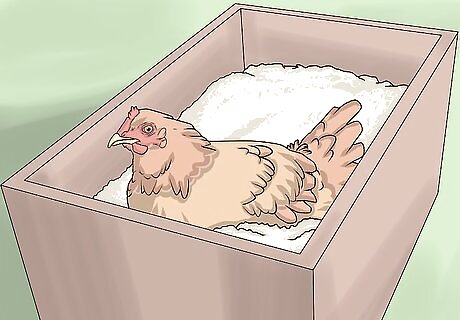
Provide dry dirt or sand for your chickens to dust bathe in. Dust bathing is a way your chickens clean themselves, and it also prevents parasites such as mites or lice from infesting your chickens. If your chickens are free-range, they might have access to sufficient dirt already.
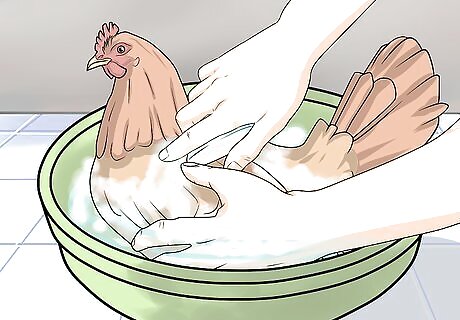
Bathe your chickens if necessary. If you’re preparing your chickens for a show, or if they’re just very dirty at the time, consider bathing them. While you’re at it, clean the coop as well! Grab a big enough tub, a mild soap, and a cup or sponge. While you're bathing them you might also trim their beaks and nails, and clip their wings too.

















Comments
0 comment